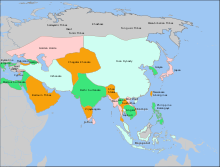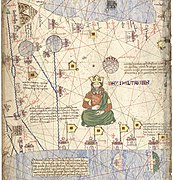Ilkhanate
Ilkhanate ایل خانان | |||||||||||||||||||||||||||||||||||||||||||||||
|---|---|---|---|---|---|---|---|---|---|---|---|---|---|---|---|---|---|---|---|---|---|---|---|---|---|---|---|---|---|---|---|---|---|---|---|---|---|---|---|---|---|---|---|---|---|---|---|
| 1256–1335[1] | |||||||||||||||||||||||||||||||||||||||||||||||
 The Ilkhanate under Ghazan | |||||||||||||||||||||||||||||||||||||||||||||||
| Status |
| ||||||||||||||||||||||||||||||||||||||||||||||
| Capital |
| ||||||||||||||||||||||||||||||||||||||||||||||
| Common languages |
| ||||||||||||||||||||||||||||||||||||||||||||||
| Religion |
| ||||||||||||||||||||||||||||||||||||||||||||||
| Government | Abu Sa'id | ||||||||||||||||||||||||||||||||||||||||||||||
| Area | |||||||||||||||||||||||||||||||||||||||||||||||
| 1310 est.[6][7] | 3,750,000 km2 (1,450,000 sq mi) | ||||||||||||||||||||||||||||||||||||||||||||||
| |||||||||||||||||||||||||||||||||||||||||||||||
The Ilkhanate or Il-khanate, also known as the Ilkhanids (Persian: ایلخانان, romanized: Īlkhānān), and known to the Mongols as Hülegü Ulus (lit. 'people or state of Hülegü'),[8] was a Mongol khanate established from the southwestern sector of the Mongol Empire. The Ilkhanid realm was officially known as the Land of Iran or simply Iran.[9][10] It was established after Hülegü, the son of Tolui and grandson of Genghis Khan, inherited the West Asian part of the Mongol Empire after his brother Möngke Khan died in 1259.
The Ilkhanate's core territory lies in what is now part of the countries of Iran, Azerbaijan, and Turkey. At its greatest extent, the Ilkhanate also included parts of modern Iraq, Syria, Armenia, Georgia, Afghanistan, Turkmenistan, Pakistan, part of modern Dagestan, and part of modern Tajikistan. Later Ilkhanate rulers, beginning with Ghazan in 1295, converted to Islam. In the 1330s, the Ilkhanate was ravaged by the Black Death. The last ilkhan, Abu Sa'id Bahadur Khan, died in 1335, after which the Ilkhanate disintegrated.
The Ilkhanid rulers, although of non-Iranian origin, tried to advertise their authority by tying themselves to the Iranian past, and they recruited historians to present the Mongols as heirs to the Sasanian Empire (224–651).[11]
Definition
According to the historian
History
Origin
When
Muhammad II's son

To the west,
In 1236 Ögedei commanded
Hulegu Khan
Due to the suspicious deaths of three
In 1262, Hulagu gave
Hulagu fell ill in February 1265 after several days of banquets and hunting. He died on 8 February and his son Abaqa succeeded him in the summer.[28]
Middle period (1265–1291)

Upon
Abaqa's death in 1282 triggered a succession struggle between his son
During Arghun's reign, he actively sought to combat Muslim influence, and fought against both the Mamluks and the Muslim Mongol emir Nawruz in Khorasan. To fund his campaigns, Arghun allowed his viziers Buqa and Sa'd-ud-dawla to centralize expenditures, but this was highly unpopular and caused his former supporters to turn against him. Both viziers were killed and Arghun was murdered in 1291.[29]
Religious shift (1291–1316)
The Ilkhanate started crumbling under the reign of Arghun's brother,
Hulagu's descendants ruled Persia for the next eighty years, tolerating multiple religions, including Shamanism, Buddhism, and Christianity, and ultimately adopting Islam as a state religion in 1295. However, despite this conversion, the Ilkhans remained opposed to the Mamluks, who had defeated both Mongol invaders and
Ghazan converted to Islam under influence of Nawrūz and made Islam the official state religion. Christian and Jewish subjects lost their equal status and had to pay the jizya (minority religion tax). Ghazan gave Buddhists the starker choice of conversion or expulsion and ordered their temples to be destroyed; though he later relaxed this severity.[32] After Nawrūz was deposed and killed in 1297, Ghazan made religious intolerance punishable and attempted to restore relations with non-Muslims.[33][34]

In terms of foreign relations, the Ilkhanate's conversion to Islam had little to no effect on its hostility towards other Muslim states, and conflict with the Mamluks for control of Syria continued. The Battle of Wadi al-Khaznadar, the only major victory by the Mongols over the Mamluk Sultanate, ended the latter's control over Syria for a few months.
For the most part, Ghazan's policies continued under his brother Öljaitü despite suggestions that he might begin to favor Twelver Shi'ism after he came under the influence of the theologians al-Allama al-Hilli and al-Bahrani.[36]
Öljeitü, who had been baptised in Christianity as an infant and had flirted with Buddhism, eventually became a Hanafi Sunni, though he still retained some residual shamanism. In 1309–10, he became a Shi'ite Muslim.[37] An Armenian scribe in 1304 noted the death of "benevolent and just" Ghazan, who was succeeded by Khar-Banda Öljeitü, "who too, exhibits good will to everyone." A colophon from 1306 reports the conversion of Mongols to Islam and "they coerce everyone into converting to their vain and false hope. They persecute, they molest, and torment," including "insulting the cross and the church".[34] Some of the Buddhists who survived Ghazan's assaults made an unsuccessful attempt to bring Öljeitü back into Buddhism, showing they were active in the realm for more than 50 years.[38]
The conversion of Mongols was initially a fairly superficial affair. The process of establishment of Islam did not happen suddenly. Öljeitü's historian Qāshāni records that Kutlushah, after losing patience with a dispute between Hanafi and Shafi'i Sunnis, expressed his view that Islam should be abandoned and Mongols should return to the ways of Genghis Khan. Qāshani also stated that Öljeitü had reverted for a brief period. As Muslims, Mongols showed a marked preference for Sufism, with masters like Safi-ad-Din Ardabili often treated with respect and favour.[39]
Disintegration (1316–1357)
Öljaitü's son, the last Ilkhan Abu Sa'id Bahadur Khan, was enthroned in 1316. He was faced with rebellion in 1318 by the Chagatayids and Qara'unas in Khorasan, and an invasion by the Golden Horde at the same time. An Anatolian emir, Irenchin, also rebelled. Irenchin was crushed by Chupan of the Taichiud in the Battle of Zanjan-Rud on 13 July 1319. Under the influence of Chupan, the Ilkhanate made peace with the Chagatais, who helped them crush the Chagatayid revolt, and the Mamluks. In 1327, Abu-Sai'd replaced Chupan with "Big" Hasan.[40] Hasan was accused of attempting to assassinate the khan and exiled to Anatolia in 1332. The non-Mongol emirs Sharaf-ud-Din Mahmud-Shah and Ghiyas-ud-Din Muhammad were given unprecedented military authority, which irked the Mongol emirs. In the 1330s, outbreaks of the Black Death ravaged the Ilkhanate and both Abu-Sai'd and his sons were killed by 1335 by the plague.[41] Ghiyas-ud-Din put a descendant of Ariq Böke, Arpa Ke'un, on the throne, triggering a succession of short-lived khans until "Little" Hasan took Azerbaijan in 1338. In 1357, Jani Beg of the Golden Horde conquered Chupanid-held Tabriz for a year, putting an end to the Ilkhanate remnant.[42]
Franco-Mongol alliance
The courts of Western Europe made many attempts to ally with the Mongols, primarily with the Ilkhanate, in the thirteenth and fourteenth centuries, starting from around the time of the Seventh Crusade in the mid-13th century. (Western Europeans were collectively called Franks by Muslims and Asians in the era of the Crusades.) Despite their shared opposition to the Muslims, primarily the Mamluk Sultanate, no formal alliance ever was concluded.[43]
Government
In contrast to the China-based Yuan dynasty, who excluded the native population from gaining control of high offices, the Ilkhanate ruled their realm through a Central Asian-Persian ("Tajik") administration in partnership with Turco-Mongol military officers. Not all of the Persian administrators were Muslims or members of the traditional families that had served the Seljuqs and Khwarazmians (e.g, the
The Ilkhanate rulers, who were keen to increase their autonomy, supported their Persian bureaucrats' promotion of the traditional Iranian idea of kingship. The Persian concept of monarchy over a territorial empire, or more specifically, the "Kingship of the Land of Iran" (pādshāhi-ye Irān-zamin), was easily sold to their Mongol masters by these bureaucrats. A lasting effect of the Mongol conquests was the emergence of the "national state" in Iran during the Ilkhanate era.[46]
The Ilkhanate Mongols remained nomadic in their way of life until the end of the dynasty. Their nomadic routes covered central
In 1330, the annexation of Abkhazia resulted in the reunification of the Kingdom of Georgia. However, tribute received by the Il-Khans from Georgia sank by about three-quarters between 1336 and 1350 because of wars and famines.[48]
Legacy

 ), sailing the Indian Ocean towards the coast of India under the control of the Delhi Sultanate (
), sailing the Indian Ocean towards the coast of India under the control of the Delhi Sultanate ( ), in the Catalan Atlas (1375).[49]
), in the Catalan Atlas (1375).[49]The emergence of the Ilkhanate had an important historical impact in
The Ilkhanate also helped to pave the way for the later
The rudiments of
Ilkhan as a tribal title in 19th/20th century Iran
The title Ilkhan resurfaced among the Qashqai nomads of southern Iran in the 19th century. Jan Mohammad Khan started using it in 1818/19, and this was continued by all the following Qashqai leaders. The last Ilkhan was Nasir Khan, who in 1954 was pushed into exile after his support of Mohammad Mosaddegh. When he returned during the Islamic Revolution in 1979, he could not regain his previous position and died in 1984 as the last Ilkhan of the Qashqai.[55]
-
Ilkhanate, Lampas textile, silk and gold; second half of 14th century.
-
1305 letter of the Ilkhan Mongol Öljaitü (official square red stamp of the Ilkhanate).
-
Seal of Ghazan
Ilkhans
| History of the Mongols |
|---|
 |
| History of Iran | |
|---|---|
 | |
| 3200–2700 | |
| Jiroft culture | c. 3100–2200 |
| Lullubi Kingdom/Zamua | c. 3100-675 |
| Elam | 2700–539 |
| Marhaši | c. 2550-2020 |
| Oxus Civilization | c. 2400–1700 |
| Akkadian Empire | 2400–2150 |
| Kassites | c. 1500–1155 |
| Avestan period | c. 1500–500 |
| Neo-Assyrian Empire | 911–609 |
| Urartu | 860–590 |
| Mannaea | 850–616 |
| Zikirti | 750-521 |
| Saparda | 720-670 |






